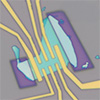| Mar 27, 2025 |
Squeezing the right amount of potassium ions between the atomic layers of molybdenum disulfide can turn it from a semiconductor into a metal, superconductor or insulator.
(Nanowerk News) The same layered material can be made to behave as a superconductor, metal, semiconductor or insulator by using a transistor device developed by RIKEN physicists to tweak its electronic properties (Nano Letters, “Gate-controlled potassium intercalation and superconductivity in molybdenum disulfide”). The method could help to uncover new superconductors.
|
|
“The variety of electronic properties based on a single material is highly intriguing to us from a materials science perspective,” says Yoshihiro Iwasa of the RIKEN Center for Emergent Matter Science, who led the team. The material is molybdenum disulfide (MoS2), which can be isolated as an incredibly thin crystal containing layers of molybdenum atoms sandwiched by sulfur atoms. These sulfur atoms can be arranged in different ways, creating two distinct phases known as 2H and 1T. The 2H phase is a semiconductor, whereas the 1T phase is metallic.
|
|
“2H molybdenum disulfide is highly promising for use in next-generation semiconductor devices,” notes Iwasa.
|
 |
| Figure 1: A photograph of the field-effect transistor. The turquoise area in the center of the inset is a flake of molybdenum disulfide, which can be a superconductor, metal, semiconductor or insulator. (© American Chemical Society)
|
|
The RIKEN researchers have now studied this phase transition in greater detail. They built a device known as a field-effect transistor and connected it to a sample of 2H molybdenum disulfide (Fig. 1). By varying the transistor voltage, they could precisely guide potassium ions into the material.
|
|
As more potassium entered the material, the material’s phase suddenly changed from 2H to 1T—roughly when there were two potassium ions for every five molybdenum atoms.
|
|
Then, by inserting the right amount of potassium and cooling the sample to –268°C, the researchers found that the 1T phase became a superconductor.
|
|
Although superconductivity had previously been seen in the 2H phase, this was unexpected for the 1T phase, and it occurred at a different temperature. “The biggest surprise for us is that we observed superconductivity when we introduced potassium ions,” says Iwasa.
|
|
More surprises were in store. The material switched from being a metal to an insulator when the researchers allowed potassium to leak out of 1T molybdenum disulfide until it contained relatively low levels of the ions, and set its temperature at –193°C.
|
|
“We found this interesting because we didn’t expect this phenomenon to occur,” says Iwasa.
|
|
These results demonstrate that introducing potassium ions in this way is a powerful method for controlling the structure and properties of two-dimensional materials like molybdenum disulfide.
|
|
“We’ve been developing this method over the past decade,” says Iwasa. “And we’ve shown that it is useful not only for exploring novel properties of superconductors and related electronic phases, but also for discovering new superconductors.”
|


